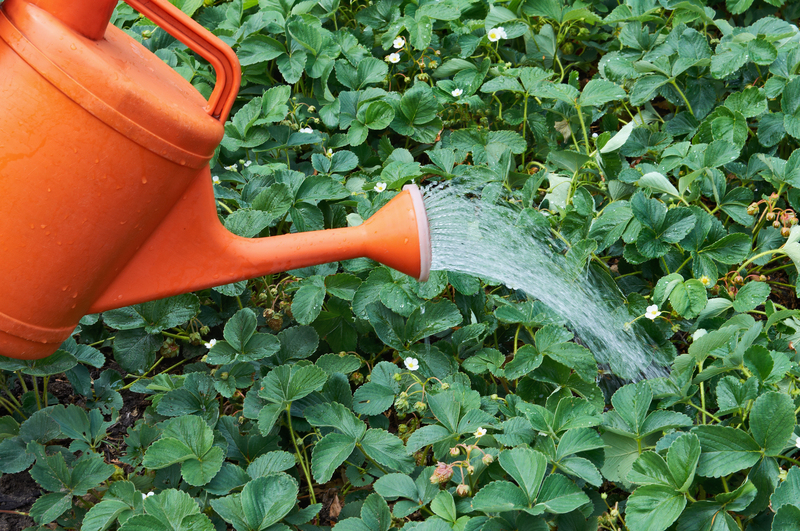Recycling Waste to Soil Enrichment
Posted on 14/06/2025
Recycling Waste to Soil Enrichment: A Comprehensive Guide
In our rapidly urbanizing world, the challenge of managing waste sustainably is more crucial than ever. Recycling waste for soil enrichment offers a double benefit: reducing the burden on landfills while enhancing the health of our soils. This approach not only supports environmentally positive outcomes but also creates valuable resources that can transform agricultural and gardening practices. In this article, we'll provide a comprehensive, SEO-friendly examination of how recycled waste materials can regenerate our soils, the processes involved, key benefits, and how you can start participating in this vital cycle.

Understanding Waste Recycling for Soil Enhancement
Before exploring practical applications, it's essential to understand what we mean by recycling waste to enrich soil. Waste recycling isn't just about plastics, glass, or metals--it also involves the conversion of organic waste into materials that feed back into the earth. This process supports a circular economy, promoting sustainability and minimizing environmental degradation.
What is Soil Enrichment?
Soil enrichment refers to improving soil quality by adding essential nutrients, organic matter, and beneficial microorganisms. Enriched soils support robust plant growth, enhance agricultural productivity, and improve the capacity of land to retain water and minerals. Traditionally, enrichment relied on chemical fertilizers, but with growing awareness of environmental impact, recycled organic waste is increasingly being used as an eco-friendly alternative.
How Does Waste Recycling Contribute to Soil Fertility?
Recycled waste, especially biodegradable materials, is processed into various soil amendments like compost, biochar, and organic mulch. Each of these plays a critical role in improving soil structure, fertility, and resilience:
- Compost: Decomposed organic matter packed with nutrients and microorganisms.
- Biochar: Charred biomass that retains soil moisture and stores carbon.
- Organic Mulch: Plant-based residues that protect soil and add nutrients upon decomposition.
Types of Waste Suitable for Soil Recycling
Not all waste is created equal when it comes to enriching soil with recycled materials. Let's delve into the main types of waste that are most valuable in this process.
Organic Kitchen Waste
- Fruit and vegetable scraps
- Coffee grounds and tea leaves
- Eggshells
- Bread crusts
Garden and Yard Waste
- Grass clippings
- Leaves
- Small pruned branches
- Flowers and plant trimmings
Agricultural By-products
- Crop residues (stalks, husks, shells)
- Manure from herbivorous animals
Properly managed, these wastes can be powerful agents of organic soil enrichment. However, it's important to exclude dairy, meat, and oils from home composting, as these attract pests and slow down decomposition.
The Process of Recycling Waste for Soil Improvement
1. Sorting and Collecting Waste
Effective waste separation forms the first step. By sorting biodegradable from non-biodegradable materials, we ensure only safe, nutrient-rich matter enters the soil cycle.
2. Composting: The Cornerstone of Waste-to-Soil Recycling
Composting converts raw organic matter into stable, humus-rich soil amendments through aerobic decomposition. This process involves microorganisms breaking down organic compounds, resulting in crumbly, dark material commonly known as
- Aerobic Composting: Requires oxygen, regular turning, and balanced carbon-nitrogen ratios.
- Vermicomposting: Utilizes worms to accelerate decomposition and add extra nutrients.
- Bokashi Composting: Ferments kitchen scraps anaerobically, suitable for small spaces.
3. Creating and Applying Biochar
Biochar is produced through pyrolysis--burning organic waste in low-oxygen conditions. The resulting charcoal-like substance is highly porous, enhancing soil structure, water retention, and providing a habitat for beneficial microbes. When biochar is mixed into soil, it increases fertility and sequesters carbon, aiding climate change mitigation.
4. Utilizing Green Manure and Mulch
- Green Manure: Fast-growing cover crops, like clover or vetch, are grown and then incorporated into the soil to boost organic matter and nitrogen.
- Mulch: Layers of organic material (leaves, straw) placed on the soil surface minimize evaporation, suppress weeds, and gradually decompose to feed the soil.
Benefits of Recycling Waste for Soil Enrichment
The practice of recycling waste to regenerate soil health offers numerous advantages for individuals, communities, and the planet.
- Improved Soil Fertility: Adds macro and micronutrients essential for plant growth, resulting in better crop yields and healthier gardens.
- Enhanced Soil Structure: Increases soil porosity and aeration, promoting deeper root penetration and improved water infiltration.
- Water Conservation: Organic matter retains moisture, reducing irrigation needs and helping plants weather drought.
- Reduced Landfill Burden: Diverts significant organic waste from landfills, cutting methane emissions--one of the most potent greenhouse gases.
- Carbon Sequestration: Practices like biochar lock carbon in the soil for centuries, reducing atmospheric CO2.
- Cost-effective: Creates high-quality soil amendments with little or no financial cost to the gardener or farmer.
- Pest and Disease Suppression: Diverse soil biota from composted material enhance plant immunity and deter harmful pests.
Common Methods of Household Waste Recycling for Soil
Home Composting
Home composting is achievable on almost any scale, from kitchen countertop bins to large garden piles.
- Choose a compost bin: Enclosed tumblers, wooden boxes, or simple open-air piles all work effectively.
- Balance greens and browns: Layer "green" materials (food scraps, grass clippings) with "browns" (dry leaves, cardboard, straw) to optimize decomposition.
- Maintain moisture and aeration: Keep material as damp as a wrung-out sponge and turn the pile weekly to introduce oxygen.
- Wait for transformation: Finished compost is dark, crumbly, and earthy in smell, usually ready in 2-6 months depending on conditions.
Community and Municipal Composting
Many cities now offer organic waste collection services. Participants leave kitchen and yard waste in special bins for pickup. This material is processed in large-scale composting or anaerobic digestion facilities, where optimal temperatures and careful monitoring achieve rapid transformation into clean, nutrient-dense soil amendments.
Urban and Rooftop Composting
For city dwellers with limited space, small-scale solutions like vermicomposting bins (using worms) or Bokashi buckets are practical.
Farming and Agricultural Recycling
Farmers have unique opportunities to recycle crop residues, livestock manure, and even food processing by-products at much larger scales. Modern sustainable agriculture increasingly recognizes compost and biochar as foundational tools for long-term soil health.
Challenges in Recycling Waste for Soil Enrichment
Despite clear benefits, adopting waste-to-soil recycling faces several hurdles:
- Contamination: Presence of plastics, chemicals, or diseased materials in compost can harm the soil and plants.
- Lack of Awareness: Many people remain unaware of how to compost effectively or the broader impact of organic waste recycling.
- Time and Space Constraints: Urbanization often means less space for composting or slower adoption rates.
- Policy and Regulation: Not all regions have robust infrastructure for municipal organic recycling programs.
How to Start Enriching Soil with Recycled Waste: Step-by-Step
1. Educate Yourself and Others
- Research best composting practices for your climate and living situation.
- Share knowledge with neighbors, schools, or local organizations to build community buy-in.
2. Set Up a Collection System
- Place a kitchen caddy or bin for daily organic waste.
- Designate an outdoor area for storing yard trimmings or other larger items.
3. Choose the Right Composting Method
- For small spaces, use worm bins or Bokashi systems.
- In backyards, build compost piles or use tumblers.
- Explore community compost drop-off points if home composting isn't feasible.
4. Monitor and Maintain
- Check moisture levels and add water or dry materials as needed.
- Aerate the pile/pile regularly to speed up decomposition.
- Ensure you're not adding problematic materials (e.g., pet waste, oils, or treated wood).
5. Use Finished Compost for Soil Enrichment
- Mix the finished product into garden beds, landscaping, or even potted plants.
- Share excess compost with neighbors or community gardens.
Smart Practices to Maximize Soil Health from Waste Recycling
- Test Your Soil: Analyze your soil before and after organic amendments to track improvements and target deficiencies.
- Rotate Compost Inputs: Use a diversity of materials--both "green" and "brown"--for a balanced nutrient profile.
- Apply at Key Times: Add compost before planting season and as a mulch during the growing season for best results.
- Encourage Native Microbes: Avoid chemical pesticides that can disrupt soil microbial communities.
- Combine Techniques: Use compost, biochar, and mulch together for compounding benefits.

The Global Impact of Waste Recycling for Soil Regeneration
On a global scale, recycling waste for soil regeneration is a critically underutilized climate solution. By diverting billions of tons of organic waste from landfills and returning vital nutrients to the land, we can address food security, curb greenhouse gases, and heal degraded ecosystems.
- Global Initiatives: Programs like the United Nations' Zero Waste Initiative and the Soil Health Partnership are encouraging cities and farmers worldwide to adopt
circular waste management models. - Agroecology: Integrating organic waste reuse within agroecological systems enhances both productivity and biodiversity.
Conclusion: A Greener Future Through Waste-to-Soil Enrichment
The transformation of waste into a resource for soil enhancement is not just a necessity--it's an opportunity. By adopting recycling waste to soil enrichment practices, each of us can play a part in building a sustainable, resilient food system and a healthier environment. Whether at home, in the garden, or on the farm, every effort counts towards restoring the earth for future generations.
- Start small, think big: Every banana peel or yard clipping returned to the soil makes an impact.
- Inspire change: Share your knowledge and experience to encourage others.
- Support initiatives: Advocate for policies and programs that make organic recycling accessible for all.
Together, let's transform waste into growable wealth and pave the way for a greener, more productive planet.

